Читать книгу Decision Intelligence For Dummies - Pamela Baker - Страница 42
Living with the fact that we have answers and still don’t know what to do
ОглавлениеDecision modeling is maturing to include more pointed pursuits, broader considerations in the decision-making processes, and more accountability for the results. It won’t surprise you to hear that this new phase is also labeled decision intelligence and that it’s measured by the value of its outputs, whether that’s in terms of impact or return on investment or both.
There is no more time, patience, or money for fishing in data lakes or panning for gold in data streams in the hope of discovering valuable knowledge. Decision intelligence insists on moving with purpose to achieve a predetermined end whose significance has been well defined.
When considering where to apply decision intelligence to your own circumstances, boil down the problem to its truest essence.
Here’s a handy example: You may ask the data what the weather will be like tomorrow. But that isn’t the question. Nor will the answer “Partly cloudy with a high of 70 degrees” be of any significant use to you.
Think hard. What is it that you really want to know?
Perhaps it’s whether to plan a picnic tomorrow. In that case, you likely need an assessment of the weather, plus pollen counts, projected traffic at the park, and maybe even water sports availabilities and/or wait times for picking up prepacked picnic lunches at your favorite deli.
Perhaps you wanted the analytics to tell you that your best pick for a picnic tomorrow is “Happy Park on the north beachside with shelter from the wind but not the warmth of the sun, and plenty of tables, because it’s not a high traffic park. Also, your route has three delis, and two have less than a 10-minute wait for order pickups.”
Decision intelligence can be applied for a relatively-speaking best decision for a problem or question of any size, ranging from the highly personalized (like the picnic questions) to the truly huge (like a global pandemic).
I talk earlier in this chapter about how the COVID-19 epidemic revealed the limits of a data driven approach to problem solving. Some of the lapses in the initial response to the epidemic were certainly caused by the urgency of the threat and the novelty of both the virus and the vaccines. Yet several factors worked in favor of making sound public health decisions under pressure. For one, Israel struck a deal with Pfizer to share patient data on the efficacy and side effects of the Pfizer vaccine in real world use. Israel also has one of the world’s most efficient healthcare systems, complete with highly developed electronic healthcare records (EHRs) capable of collecting massive patient data in real time. The resulting database is well organized and filled with clean data — accurate and up-to-date data, in other words — which was vital to both understanding the disease and testing the vaccine.
Further, scientists, healthcare workers, and public health organizations around the world shared data and collaborated on finding insights and answers. The global response to the pandemic was a stellar display of how effective humankind can be in tamping down any threat when countries, health entities, and experts cooperate. The effort should be celebrated and commemorated for time eternal.
But all decision-makers can also learn from the shortcomings as well as the successes in this huge undertaking to end a dangerous pandemic. Chief among the shortcomings is that there is still uncertainty, after many months, about the specific actions that should be taken despite massive global data sets and ongoing analysis.
Businesses and other organizations find themselves in a similar predicament even in the absence of urgency, alarm, and dire consequences. In other words, even with the luxury of time and calmer heads, you can glean insights from data and still not know what to do about or with them. To put this in proper context, you should always remember this:
Data will never be omnipotent, and you will always have to deal with some level of uncertainty.
Even so, you can and should improve how you make decisions and judge them by their real world impacts. That requires the combined applications of several disciplines and more human input — a more than fitting definition of decision intelligence.
